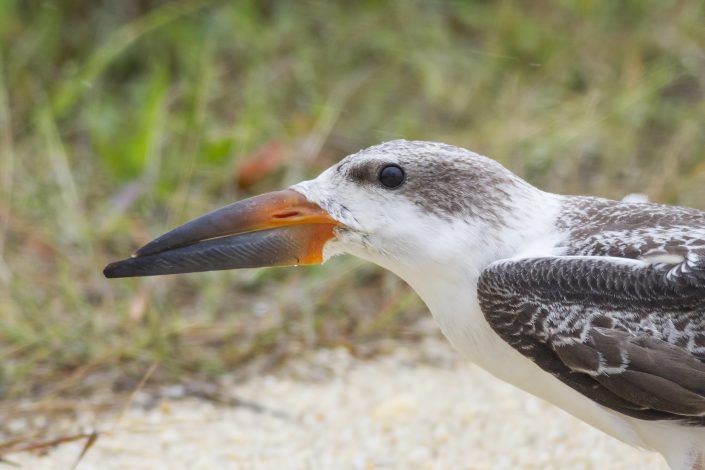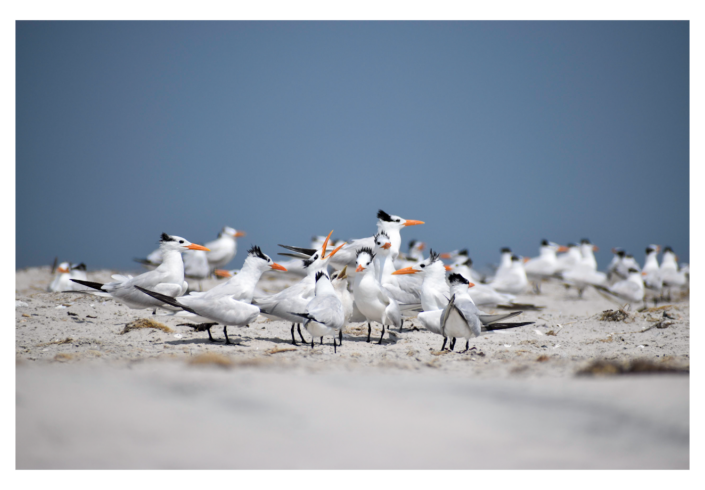New Jersey’s Beach Nesting Birds Struggle in 2023
by Todd Pover, Senior Wildlife Biologist
This year was an especially challenging one for beach nesting birds in New Jersey. Most of the species fared poorly on a statewide basis, and even though they can withstand periodic down years, several trends are worrisome to biologists and wildlife managers.
The state’s piping plover breeding population remained the same as last year with 118 pairs, which is also about the same as the long-term average since federal listing. However, productivity was just 0.53 chicks fledged per pair, the second lowest since federal listing and well below the levels believed necessary to grow the population. Of particular concern, productivity has been low for three consecutive years after a number of years of above average success. Productivity is one of the main drivers of population (up or down) and small populations are especially sensitive to even small changes, so it is expected that the population is likely to drop over the next few years, further stagnating plover recovery in the state.
Meanwhile, there was a record number (53) of breeding pairs of piping plovers at Holgate, a unit of the Edwin B. Forsythe National Wildlife Refuge, that is monitored by CWF through a cooperative agreement with the Refuge. This positive trend, almost a four-fold increase has occurred since Superstorm Sandy enhanced the habitat for plovers at the site, has been an ongoing highlight for the state in recent years. Nonetheless, it has not been accompanied by similar increases elsewhere in the state, so it has not led to any statewide recovery. Productivity for the large concentration of piping plovers at Holgate was above the statewide average in 2023 but the lowest level over the past decade, so it was also a down year for this site, where expectations typically run high that it will help boost statewide productivity.
Black skimmers, a state endangered species, were one of the relative bright spots for beach nesting birds this year. The known statewide breeding population was its highest in the past 10 years at 2,685 adults. With 802 fledglings produced across three major colonies at Holgate, Horseshoe Island, and Stone Harbor, skimmers recorded moderately good productivity overall. About half of those fledglings came from Holgate and Horseshoe Island, sites monitored (or co-monitored) by CWF.

Photo courtesy of Sam Galick.
Least terns, another state endangered colonial-nesting species, fared far poorer. The breeding population of 1059 adults was within the past 10-year range, but productivity was extremely low. Only 152 fledglings were recorded coastwide, and only three colonies produced fledglings. Holgate had, by far, the largest colony in the state, but even that site only produced 70 fledglings. Of great concern, there were only 13 active colonies in 2023, nearly half the number just two years ago and the lowest count since 1976.
Although American oystercatchers are not monitored in all their breeding habitats in New Jersey – only a small portion of the marsh nesters are tracked – the population nesting on sandy Atlantic coast beach habitat continued its increase over the past two decades. The 146 nesting pairs recorded in 2023 is nearly triple the tally from when regular monitoring began in 2003. Unfortunately, productivity was low at just 0.32 chicks fledged per pair, however, as a long-lived species the annual level needed to grow their population is not as high as a shorter-lived species, such as piping plovers. Sticking with a pattern seen across the species this year, American oystercatchers did well at Holgate, its 50 pairs – the most for any individual site in the state – produced 0.72 fledglings per pair, nearly four-fifths of the sandy beach chicks that fledged coastwide. CWF, in partnership with The Wetlands Institute, also tracked about 20 pairs of oystercatchers on the Delaware Bayshore in 2023, the first time that comprehensive monitoring of that breeding population has been undertaken.
One of the most interesting bits of “beach-nester” news this year was the continuing increase in the royal tern breeding colony at Horseshoe Island. Coming in at just over 400 pairs at its peak, the colony grew from just 90 pairs last year. It is the northernmost colony along the Atlantic Coast of the U.S. and at times when breeding adults, chicks, fledglings, and staging migrants are all present, well over 1000 in total, it can be one of the most spectacular coastal “sights” in New Jersey.

Photo courtesy of Emmy Casper, CWF Wildlife Biologist.
Note: The data sources for information reported here are from CWF biologists and New Jersey Fish and Wildlife – Endangered and Nongame Species Program reports. The full state reports are available by clicking below.
Leave a Comment
Sadly, it was a difficult year for chicks of all species of shore birds! This is worrisome and a reminder that we have to be vigilant and continue the efforts to restore shore bird populations! As a NJ wildlife volunteer who lives inland and north, I am so grateful that NJ has such dedicated biologists and volunteers who make the effort to protect these beautiful birds and their habitat.
Comments are closed.